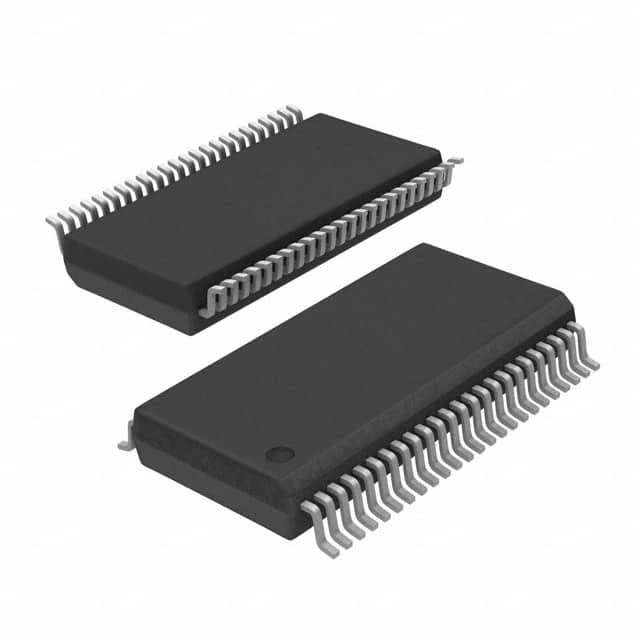Xem thông số kỹ thuật để biết chi tiết sản phẩm.

74LVX16245TTR
Product Overview
Category
The 74LVX16245TTR belongs to the category of integrated circuits (ICs). Specifically, it is a 16-bit bus transceiver with 3-state outputs.
Use
This IC is commonly used for bidirectional data transfer between two buses. It allows data transmission in both directions and provides a high level of flexibility in various digital applications.
Characteristics
- 16-bit wide bidirectional bus
- 3-state outputs for multiplexed bus architecture
- Low voltage operation (2.7V to 3.6V)
- High-speed operation (up to 80 MHz)
- Schmitt-trigger inputs for noise immunity
- ESD protection for robustness
Package
The 74LVX16245TTR is available in a TSSOP (Thin Shrink Small Outline Package) package. This package offers a compact size and good thermal performance.
Essence
The essence of the 74LVX16245TTR lies in its ability to facilitate efficient bidirectional data transfer between two buses. It acts as a bridge, enabling seamless communication between different parts of a digital system.
Packaging/Quantity
The 74LVX16245TTR is typically sold in reels containing a quantity of 2500 units per reel.
Specifications
- Supply Voltage: 2.7V to 3.6V
- Input Voltage: 0V to VCC
- Output Voltage: 0V to VCC
- Operating Temperature Range: -40°C to +85°C
- Propagation Delay: 5 ns (max)
- Output Current: ±24 mA
Detailed Pin Configuration
The 74LVX16245TTR has a total of 48 pins, which are divided into four groups: A, B, OE (Output Enable), and GND/VCC.
- Group A (pins 1-16): Bus A inputs/outputs
- Group B (pins 17-32): Bus B inputs/outputs
- Group OE (pins 33, 36, 38, 41, 43, 46): Output enable pins
- Group GND/VCC (pins 8, 24, 40, 56): Ground and power supply pins
For a detailed pin configuration diagram, please refer to the datasheet of the 74LVX16245TTR.
Functional Features
- Bidirectional data transfer between two buses
- 3-state outputs for multiplexed bus architecture
- Schmitt-trigger inputs for noise immunity
- ESD protection for enhanced robustness
- High-speed operation for efficient data transmission
Advantages and Disadvantages
Advantages
- Flexible bidirectional data transfer capability
- Low voltage operation for power efficiency
- High-speed operation for fast data transmission
- Noise immunity due to Schmitt-trigger inputs
- Robustness against electrostatic discharge (ESD)
Disadvantages
- Limited to 16-bit bus width
- Requires careful handling due to sensitivity to static electricity
Working Principles
The 74LVX16245TTR operates by receiving input signals from one bus (A) and transmitting them to another bus (B), or vice versa. The direction of data flow is controlled by the output enable pins (OE). When the OE pins are active, the IC allows bidirectional data transfer. When the OE pins are inactive, the outputs are in a high-impedance state, effectively disconnecting the IC from the buses.
Detailed Application Field Plans
The 74LVX16245TTR finds applications in various digital systems where bidirectional data transfer is required. Some common application fields include:
- Microcontrollers and microprocessors
- Data communication systems
- Memory interfaces
- Industrial automation
- Automotive electronics
Detailed and Complete Alternative Models
- SN74LVX16245: Similar 16-bit bus transceiver with 3-state outputs, offered by Texas Instruments.
- MC74LVX16245: Another 16-bit bus transceiver with 3-state outputs, provided by ON Semiconductor.
- CD74LVX16245: 16-bit bus transceiver with 3-state outputs, available from Texas Instruments.
These alternative models offer similar functionality to the 74LVX16245TTR and can be considered as substitutes in various applications.
In conclusion, the 74LVX16245TTR is a versatile integrated circuit that enables efficient bidirectional data transfer between two buses. Its low voltage operation, high-speed capability, and robustness make it suitable for a wide range of digital applications.
Liệt kê 10 câu hỏi và câu trả lời thường gặp liên quan đến ứng dụng 74LVX16245TTR trong giải pháp kỹ thuật
Sure! Here are 10 common questions and answers related to the application of 74LVX16245TTR in technical solutions:
Q: What is the 74LVX16245TTR? A: The 74LVX16245TTR is a 16-bit bus transceiver with 3-state outputs, commonly used for bidirectional data transfer between different voltage levels.
Q: What is the operating voltage range of the 74LVX16245TTR? A: The 74LVX16245TTR operates within a voltage range of 2.7V to 3.6V.
Q: Can the 74LVX16245TTR handle level shifting between different voltage domains? A: Yes, the 74LVX16245TTR can be used for level shifting between different voltage domains, making it suitable for interfacing between devices with different voltage requirements.
Q: How many channels does the 74LVX16245TTR have? A: The 74LVX16245TTR has 16 bidirectional channels, allowing for simultaneous data transfer in both directions.
Q: What is the maximum data transfer rate supported by the 74LVX16245TTR? A: The 74LVX16245TTR supports high-speed data transfer rates up to 400 Mbps.
Q: Can the 74LVX16245TTR be used in applications requiring hot-swapping capability? A: Yes, the 74LVX16245TTR supports hot-swapping, allowing for safe insertion and removal of devices without disrupting the operation of the system.
Q: Does the 74LVX16245TTR have built-in ESD protection? A: Yes, the 74LVX16245TTR is designed with built-in ESD protection, providing robustness against electrostatic discharge events.
Q: What is the power supply current consumption of the 74LVX16245TTR? A: The power supply current consumption of the 74LVX16245TTR varies depending on the operating conditions, but it typically ranges from a few milliamperes to tens of milliamperes.
Q: Can the 74LVX16245TTR be used in automotive applications? A: Yes, the 74LVX16245TTR is suitable for automotive applications as it meets the necessary requirements for temperature range, voltage tolerance, and reliability.
Q: Are there any specific layout considerations when using the 74LVX16245TTR? A: Yes, it is recommended to follow the manufacturer's guidelines for proper PCB layout, including minimizing trace lengths, providing adequate decoupling capacitors, and ensuring signal integrity for high-speed data transfer.
Please note that these answers are general and may vary depending on the specific application and requirements. It is always advisable to refer to the datasheet and consult with the manufacturer for detailed information and application-specific guidance.

